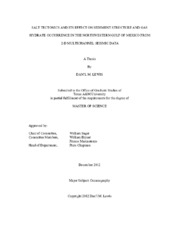| dc.description.abstract | This study was undertaken to investigate mobile salt and its effect on fault structures and gas hydrate occurrence in the northwestern Gulf of Mexico. Industry 2-D multichannel seismic data were used to investigate the effects of the salt within an area of 7,577 mi^2 (19,825 km^2) on the Texas continental slope in the northwestern Gulf of Mexico. The western half of the study area is characterized by a thick sedimentary wedge and isolated salt diapirs whereas the eastern half is characterized by a massive and nearly continuous salt sheet topped by a thin sedimentary section. This difference in salt characteristics marks the edge of the continuous salt sheets of the central Gulf of Mexico and is likely a result of westward decline of original salt volume. Beneath the sedimentary wedge in the western part of the survey, an anomalous sedimentary package was found, that is described here as the diapiric, gassy sediment package (DGSP). The DGSP is highly folded at the top and is marked by tall, diapiric features. It may be either deformed shale or the toe of a complex thrust zone detaching the sedimentary wedge from deeper layers. The dataset was searched for the occurrence of bottom simulating reflectors (BSRs), as they are widely accepted as a geophysical indicator of gas trapped beneath gas hydrate deposits, which are known to occur farther east in the Gulf. Although, many seismic signatures were found that suggest widespread occurrence of gas within the upper sediment column, few BSRs were found. Even considering non-traditional definitions of BSRs, only a few occurrences of patchy and isolated BSRs features were identified. The lack of traditional BSRs is likely the result of geologic conditions that make it difficult to recognize gas hydrate deposits. These factors include: (1) unfavorable layer geometries, (2) flow of warm brines from depth, (3) elevated geotherms due to the thermogenic properties of salt and its varying thickness, and (4) widespread low porosity and permeability sediments within the gas hydrate stability zone. | en |


